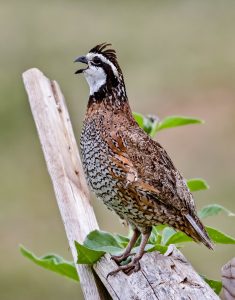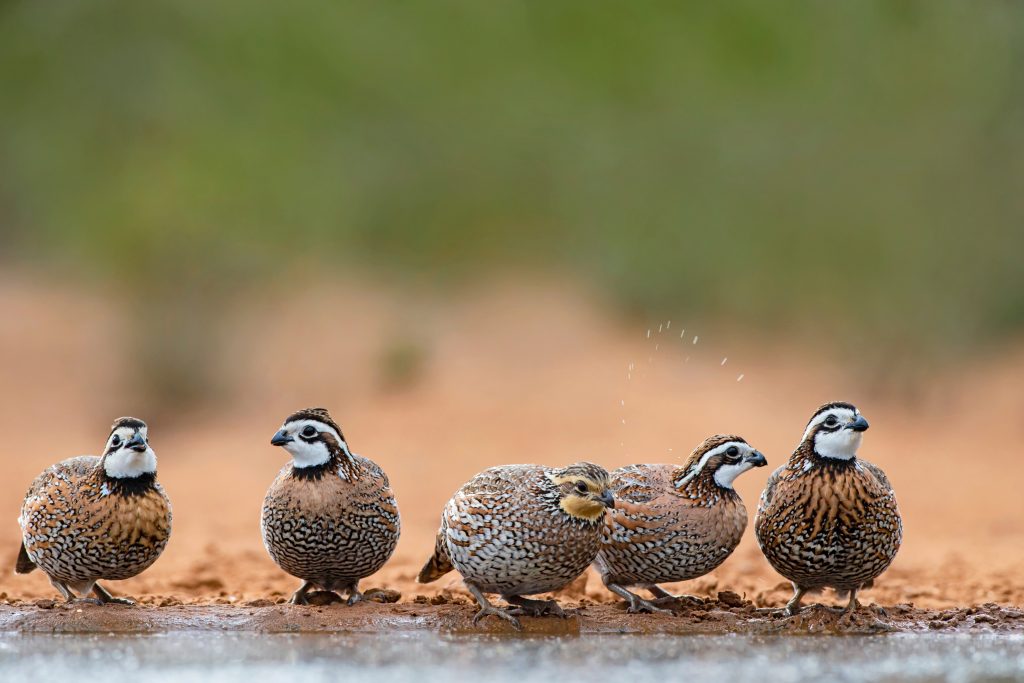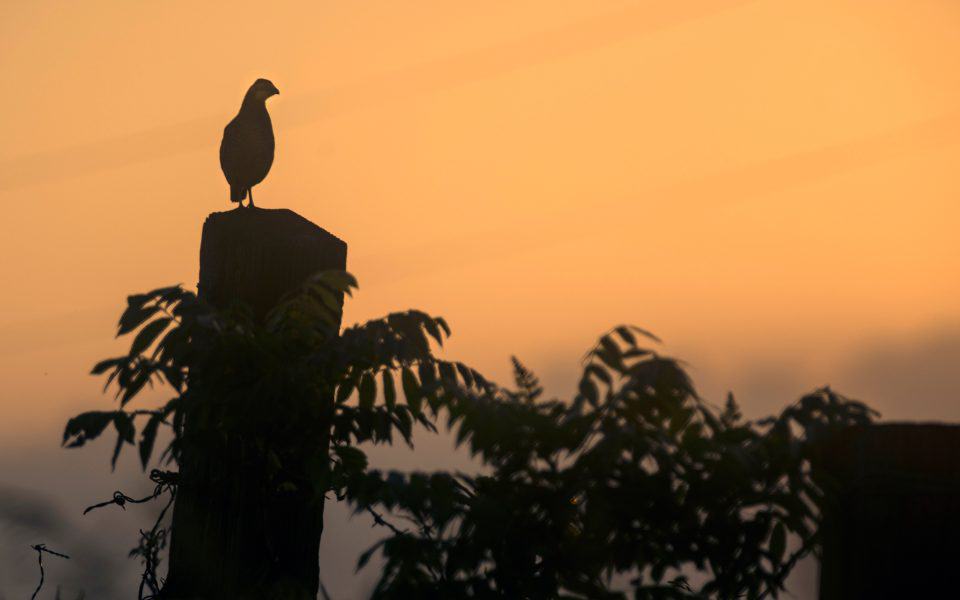Using an orange softball as a quail habitat measuring stick is just one of the tips gleaned from the South Carolina Bobwhite Initiative booth during the S.E. Wildlife Expo in Charleston. The premise is to take the softball into well-managed quail woods and drop it or toss it, and if you can still see any of the color orange, then your habitat in that spot is lacking. One can have acres and acres of grass under mature pines, and still be lacking the weedy, brushy habitat that quail depend on. Setting back successional habitat utilizing prescribed fire, winter disking and forestry practices is the recipe for bringing back the bobwhites.
 Michael Hook is the Small Game Project Coordinator for the South Carolina Department of Natural Resources (SCDNR) and is the chair of the National Bobwhite and Grassland Initiative (NBGI) Technical Committee. This committee includes 25 states today, and Hook will travel to Michigan on March 28 to address their annual meeting, but the committee has South Carolina roots, too. In March of 2009, what was then known as the Southeast Quail Study group held their first joint meeting with the Partners in Flight and the linkage between grassland songbirds and bobwhite quail was established. This humble outdoor writer and bobwhite enthusiast was present that day to write a story for a local newspaper.
Michael Hook is the Small Game Project Coordinator for the South Carolina Department of Natural Resources (SCDNR) and is the chair of the National Bobwhite and Grassland Initiative (NBGI) Technical Committee. This committee includes 25 states today, and Hook will travel to Michigan on March 28 to address their annual meeting, but the committee has South Carolina roots, too. In March of 2009, what was then known as the Southeast Quail Study group held their first joint meeting with the Partners in Flight and the linkage between grassland songbirds and bobwhite quail was established. This humble outdoor writer and bobwhite enthusiast was present that day to write a story for a local newspaper.
“Our efforts here in South Carolina are based on the NBGI’s national plan, and each state gets to choose how much of that plan they want to implement,” said Hook. “The overall goal is to create quail habitat on the landscape level. Just a few generations ago many counties consisted of postage-stamp sized farms that backed up to one another, unintentionally creating premium quail habitat. Many of those folks burned woods for tick and snake control purposes, and that also embraced the bobwhite’s needs.”
“Today we have cleaner agricultural practices and many rural residents appreciate a clean looking homesite or ditch bank that is easily achieved using a bush hog,” said Hook. “I often joke that if we could ban the bush hog on a landscape scale then we’d have a lot more quail habitat. Letting fields go fallow for a time can produce a messy look with a woody component, but that is actually great for quail habitat as they like it open on the ground for movement, but with plenty of cover overhead from hawks.”

Walter Eastland
“We like to think that quail need three types of cover including nesting, brood rearing and escape cover,” said Hook. “So avoid a monoculture, like having nothing but grass under mature pines, which makes good nesting habitat, but then leaves them lacking brood and escape cover. Brood cover can consist of beggar’s lice, ragweed and wildflowers. Escape cover success comes in the form of blackberry brambles, sumac and even small patches of sweetgum. To my way of thinking, the habitat softball will easily disappear if dropped into each of these well-maintained habitats.”
“In South Carolina we have hired several biologists in conjunction with the Farm Bill to reach out to private landowners,” said Hook. “We need these landowners because there are not enough public lands to make this initiative work. These biologists visit private property and give technical advice or help create management plans. In some cases, the National Resources Conservation Service (NRCS) has money to put towards implementation of quail habitat programs on private lands.”
Over in Georgia, biologist Reggie Thackston brings 40-years of quail habitat management to the table for Thackston Wildlife Consulting. Thackston just completed twelve years on the board at Tall Timbers as Chair of the Science and Land Management Committee, and was the Georgia State Quail Project Leader before that. “Before we micro-manage the first block of cover at any property I recommend looking at the overall landscape of the area to help determine what the chance is for quail restoration to work,” said Thackston. “Even if the landowner does everything right, but you are in a bad landscape, then it won’t work.”
“There’s approximately 700,000-acres of land in South Georgia and Northwest Florida committed to quail habitat,” said Thackston. “That area is one of the best examples of landscape-scale management that we have. Elsewhere, landowners don’t always understand which properties are an island, located away from any other properties under quail management. I’d say the base acreage to succeed in quail restoration if you are an “island property” would be around 1500-acres. The intensity of pine thinning and prescribed fire in those acres will greatly determine quail numbers.”

Danita Delimont
“I recommend thinning the pines to a basil area of 40 for the best response from bobwhites,” said Thackston. “Many times landowners stop thinning at a basil area of 60 because it is attractive for deer and turkeys, and that does help quail, but it’s not doing as much as could be done. This goes back to the primary evaluation, and letting landowners know what they can expect regarding management responsibilities, and gamebird returns. Then we set up what I call quail sources, where quail can thrive, and eliminate what I call quail sinks, where quail go to die.”
“A sink might be an unthinned pine stand, or a hardwood corridor that is a known predator hangout and ambush point,” said Thackston. “Even excessive blackening of the landscape from a site prep burn can be a sink, and I recommend planting cover in any area where the seedbed gets scorched, to eliminate that sink. Right after a clearcut and replant, a loblolly stand is great for quail, and the first two to four years that area is a source for quail, but once the canopy closes, this area tanks quickly as a quail habitat hotspot. Then that first thinning at 13 to 15 years old brings that site back into being a source for quail.”
“Let’s talk about that same pine stand at maturity.” said Thackston. “A few thinning operations along the way benefitted quail habitat, but a longer sawtimber rotation would be best for quail. The yield from timber economically speaking is a big trade off when you carry a thinned pine stand past 32 years old. This leads to a decision about objectives going forward and that boils down to quail returns versus timber revenue. Even if you keep the timber stand, I still believe you need all the proverbial legs of the stool present. Those include predator control, supplemental feeding, not over-harvesting quail and good dogs. A good return for these efforts might be three to four coveys an hour while hunting on horseback.”

“Maintaining a checkerboard of habitat cover is best,” said Thackston. “And while a two-year rotation on fire is a good standard on most lands in the Southeast, managers can get a little creative after that. Vary the size of the blocks from 20 to 40 acres, and go with whatever size works on your landscape. Also, a block does not need to always be square in shape, although that works best when plowing fire lines. We can reach solid data for a property, such as having one quail per acre or one-half quail per acre, by keeping hunt records and doing quail counts.”
Meanwhile, in the real world of the small private landowner, put and take quail hunting on weekends using one’s own dog is likely a familiar recipe. Released quail that survive 30-days in the woods are essentially going to act nervous and provide a good challenge for any canine to locate. These types of outings can be the precursor to frequenting quail preserves to hunt, which further fuels the fire for upland hunting. Going back to the NBGI message, we need more folks with the desire to quail hunt, and that may lead to better management practices on the landscape for quail, as people begin to consider bobwhite habitat on a daily basis.
Jeff Dennis is a longtime outdoorsman. Read his blog at Lowcountry Outdoors.
Join our weekly newsletter or subscribe to GameKeepers Magazine.
Your source for information, equipment, know-how, deals and discounts to help you get the most from every hard-earned moment in the field.







